The Sandy Bridge Preview
by Anand Lal Shimpi on August 27, 2010 2:38 PM ESTAdobe Photoshop CS4 Performance
To measure performance under Photoshop CS4 we turn to the Retouch Artists’ Speed Test. The test does basic photo editing; there are a couple of color space conversions, many layer creations, color curve adjustment, image and canvas size adjustment, unsharp mask, and finally a gaussian blur performed on the entire image.
The whole process is timed and thanks to the use of Intel's X25-M SSD as our test bed hard drive, performance is far more predictable than back when we used to test on mechanical disks.
Time is reported in seconds and the lower numbers mean better performance. The test is multithreaded and can hit all four cores in a quad-core machine.
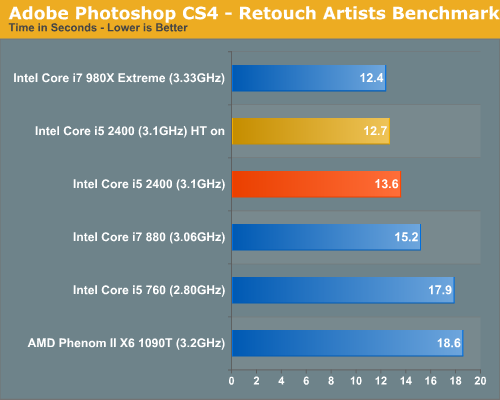
Right off the bat Sandy Bridge is killer. In our Photoshop test it’s faster than its closest quad-core price competitor, faster than its identically clocked Lynnfield, faster than AMD’s fastest and loses out only to Intel’s $999 Core i7 980X. That being said, it only takes about 9% longer to complete our benchmark than the 980X.
DivX 6.5.3 with Xmpeg 5.0.3
Our DivX test is the same DivX / XMpeg 5.03 test we've run for the past few years now, the 1080p source file is encoded using the unconstrained DivX profile, quality/performance is set balanced at 5 and enhanced multithreading is enabled:
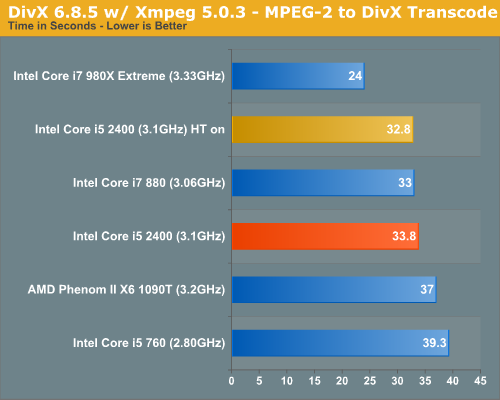
While not the most stressful encoding test, it’s still a valid measure of performance and once again, Sandy Bridge is faster than all. In this case we’re faster than the Core i5 760 (~16%) and just behind the Core i7 880. Clock for clock there's not a huge improvement in performance here (HT doesn't seem to do much), it's just a better value than the 760 assuming prices remain the same.
x264 HD Video Encoding Performance
Graysky's x264 HD test uses the publicly available x264 encoder to transcode a 4Mbps 720p MPEG-2 source. The focus here is on quality rather than speed, thus the benchmark uses a 2-pass encode and reports the average frame rate in each pass.
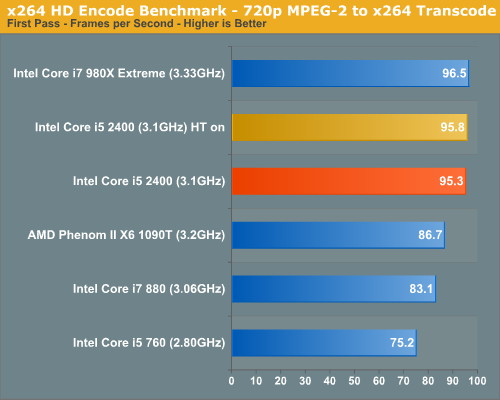
Lightly threaded performance is much improved - the 2400 is 14.6% faster than the Core i7 880.
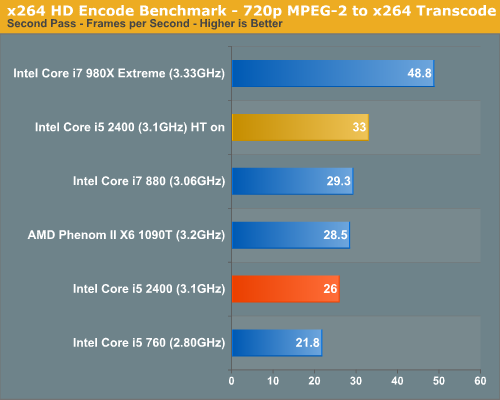
The actual encoding pass favors more threads, so we see a big improvement over the 760 (19%) but it falls short of the Core i7 880. Turn HT on and we get a 12.6% improvement over an identically clocked/configured Lynnfield.
Note that CPU based video encoding performance may not matter if Intel implemented a good video transcode engine in Sandy Bridge.
Windows Media Encoder 9 x64 Advanced Profile
In order to be codec agnostic we've got a Windows Media Encoder benchmark looking at the same sort of thing we've been doing in the DivX and x264 tests, but using WME instead.
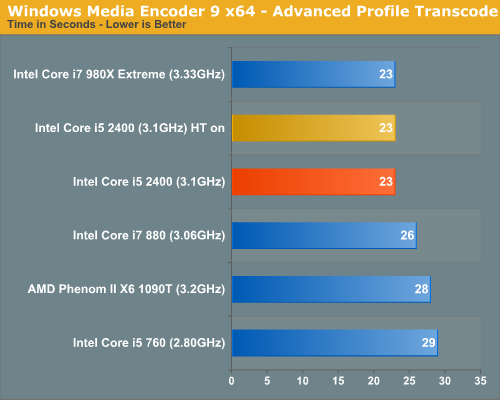
Performance in WME rarely scales anymore. Our benchmark doesn’t scale well beyond 4 cores and the only hope for performance are increases in clock speed or IPC. Sandy Bridge delivers the latter.
A 20% increase in performance vs. the similarly clocked 880 in a test that doesn’t scale with anything but IPC tells you a lot. Compared to the Core i5 760, Sandy Bridge is 26% faster.










200 Comments
View All Comments
thewhat - Monday, August 30, 2010 - link
Because the 980X is a 6 core and the 950 is a 4 core!It doesn't make sense to compare a 6 core to a 4 core when there's an $800 price difference.
A 1366 4 core (preferably at the same CPU speed) would make much more sense to see the differences in various architectures/sockets.
SteelCity1981 - Monday, August 30, 2010 - link
ok and the diff in performance would be what now? if they are showing you the diff and how well the new 2 gen cpu's are to even a $1000 cpu what makes you think that the Core i7 950 which is slower in performance then a 980X would fair? I mean it's common logic that if the 2nd gens can run almost on par in many bench test with a 980X then obv it's going to run better then the Core i7 950's.kake - Sunday, August 29, 2010 - link
Damn you Intel! Damn you to hell!!I have been living with an AMD Athlon XP 1800+ since 2003ish. This was mostly because I liked the Soundstorm that did a very good Dolby Digital Live output. For the last eight months I've been having to run it at about 2/3rds speed because all the caps on the motherboard burst, and it ran at 80C all the time. The GPU fan died and I wired a 80mm fan on top of it, but it had overheated once too often to do any 3D work. The DVD burner wouldn't read or write, the DVD reader wouldn't open except under duress. The SATA bus started to scramble any data read or written through it, the second LAN port (the good one) died, and the USB would usually demand a musical chairs routine with the mouse and keyboard to get them to work.
So last week I bought all the bits and built a very reasonably priced (370 with shipping and tax) i3-530 based HTPC. I've never seen anything so gorgeous as the first time I played Avatar in 1080p on the plasma.
And now you tell me all this?
Damn you Intel, I'm sick of progress.
juampavalverde - Sunday, August 29, 2010 - link
There is a technological reason to bury 2 sockets that are still alive? they are screaming performance yet! i dont get what intel wants with this behavior, ¿Hate from the IT sector? i love the performance, but it is designed in a so closed and trickery way, and completely dropping two nice and stablished platforms, this thing wants to be hated. I hope amd destroys this crazy ideas of intel with llano oem sales, even being inferior in cpu performance.Googer - Monday, August 30, 2010 - link
What exactly does a Lifestyle processor do?mino - Monday, August 30, 2010 - link
Probably cuts your hair while playing Crisis :)Googer - Monday, August 30, 2010 - link
More like it shops for a convertible for you while you worry about your hair loss in your mid life Crysis.Googer - Monday, August 30, 2010 - link
More like it shops for a convertible for you while you worry about your hair loss in your mid life Crysis.Googer - Monday, August 30, 2010 - link
I understand what the difference between unlocked, regular, and power saving CPUs are. But what exactly does Intel mean by a Lifestyle processor? How is it different from the others? What exactly is a "Lifestyle CPU"?zepi - Monday, August 30, 2010 - link
What does the mystical "load power" mean? Does it mean running Prime95, Furmark, both or even something "real world" like Starcraft 2?